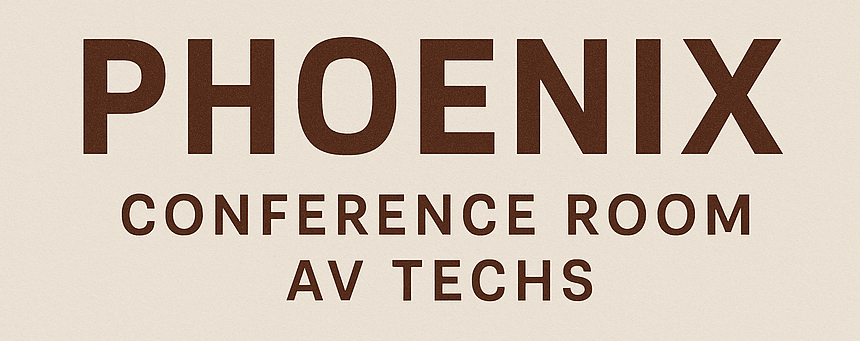Guide to Structured AV Cabling in Arizona
Introduction
Structured AV cabling forms the backbone of modern audiovisual (AV) systems across Arizona’s commercial, educational, and industrial facilities. From high-performance video conferencing to enterprise-grade control rooms, structured cabling provides the organized, scalable infrastructure that allows AV technologies to operate seamlessly. This guide explores the design principles, standards, installation practices, and benefits of structured AV cabling in Arizona—helping businesses future-proof their audiovisual networks.
Understanding Structured AV Cabling
Structured AV cabling is a standardized system of cables, connectors, and hardware used to integrate and manage audio and video signals within a building or campus. Unlike point-to-point wiring, structured cabling creates a centralized, modular framework that supports multiple AV applications—conference rooms, auditoriums, digital signage, and control systems—without the need for re-cabling.
Key components include:
- Horizontal cabling: Connects work areas or devices to telecommunications rooms.
- Backbone cabling: Links telecommunications rooms, data centers, and entrance facilities.
- Patch panels and racks: Provide flexibility and easy maintenance.
- Pathways and enclosures: Ensure protection and organization for cables.
Why Arizona Businesses Need Structured AV Cabling
In Arizona’s fast-growing commercial hubs like Phoenix, Tucson, and Tempe, the demand for reliable and scalable AV networks is at an all-time high. Modern offices, educational institutions, and healthcare facilities rely heavily on AV communication systems that demand consistent bandwidth and minimal interference.
Advantages include:
- Enhanced performance and reliability: Reduces signal degradation for crystal-clear AV transmission.
- Simplified management: Organized cabling makes it easier to maintain and upgrade systems.
- Future scalability: Supports emerging technologies like 8K video, IP-based AV, and smart building integration.
- Cost efficiency: Minimizes downtime and reinstallation costs.
- Compliance with Arizona building codes: Ensures safety and proper fire rating.
Structured AV Cabling Standards
Compliance with national and international cabling standards is crucial. The most recognized include:
- TIA/EIA-568-D: Telecommunications cabling standard for commercial buildings.
- ISO/IEC 11801: Global structured cabling standard.
- NEC Article 725 (Low Voltage Wiring): Governs installation of low-voltage AV systems in Arizona.
- BICSI Best Practices: Industry guidelines for design, installation, and testing.
Best Practices for Designing Structured AV Cabling Systems
Designing a structured AV cabling network in Arizona requires careful planning to ensure optimal performance and compliance. Consider the following:
1. Needs Assessment
Determine the number of AV endpoints, resolution requirements, and network load.
2. Cable Selection
Use shielded Cat6A or Cat7 cables for high-speed data and 4K/8K video transmission.
3. Pathway Planning
Follow NEC and Arizona Fire Code guidelines for plenum-rated cables and proper spacing from electrical conduits.
4. Labeling and Documentation
Implement a standardized labeling system to simplify troubleshooting and future upgrades.
5. Signal Management
Incorporate signal extenders, baluns, and switches to ensure signal integrity over long distances. IT Infrastructure AV Company
Structured Cabling for AV vs. Traditional Wiring
| Feature | Structured AV Cabling | Traditional Wiring |
|---|---|---|
| Scalability | Highly scalable for future AV expansion | Limited scalability |
| Organization | Centralized and labeled | Disorganized and point-to-point |
| Maintenance | Easier and faster | Time-consuming |
| Signal Quality | Optimized for performance | Susceptible to interference |
| Cost Over Time | Lower long-term cost | Higher due to rework and downtime |
Applications Across Arizona
Structured AV cabling plays a vital role in diverse industries:
- Corporate offices: Boardrooms, training centers, and collaboration spaces.
- Educational institutions: Smart classrooms, auditoriums, and distance learning systems.
- Healthcare facilities: Operating theaters, patient monitoring, and telemedicine.
- Government buildings: Control rooms and public address systems.
- Hospitality and retail: Digital signage, video walls, and entertainment zones.
Testing and Certification
Every structured AV cabling system must undergo comprehensive testing to ensure compliance and reliability. Recommended testing includes:
- Wire mapping (verifies correct pinouts)
- Signal loss/attenuation testing
- Crosstalk and EMI analysis
- Bandwidth performance testing
Professional certification using Fluke Networks tools or equivalent ensures systems meet or exceed TIA/EIA and BICSI standards.
Future Trends in Structured AV Cabling
Arizona’s AV infrastructure is evolving with advancements such as:
- IP-based AV over Ethernet
- Fiber optic backbones for ultra-high-speed data
- Smart building integration
- Remote monitoring and cloud-based AV control
- Energy-efficient cabling materials
These trends emphasize the importance of structured systems that are flexible, durable, and ready for future technology.
Partnering with a Professional AV Cabling Contractor in Arizona
Working with a certified low-voltage and AV contractor ensures code compliance, optimal design, and long-term system reliability. Look for:
- BICSI-certified technicians
- Experience with Cat6A and fiber optics
- Knowledge of Arizona low voltage codes
- Capability in large-scale AV integration projects
A trusted Arizona-based integrator can design, install, and maintain structured AV cabling systems tailored to your business environment.
Conclusion
Structured AV cabling is the foundation of every efficient audiovisual system in Arizona. Whether in Phoenix’s corporate towers, Tucson’s universities, or Scottsdale’s healthcare facilities, structured cabling ensures seamless connectivity, scalability, and long-term cost savings. Partnering with a professional AV cabling contractor ensures compliance, performance, and future readiness. Cost to Install AV Systems in Phoenix
FAQs
Q1: What type of cabling is best for 4K video distribution?
Cat6A or fiber optic cabling is ideal for 4K/8K video due to higher bandwidth and reduced crosstalk.
Q2: How often should structured AV cabling be tested?
Testing is recommended every 12–24 months or during major upgrades.
Q3: Does Arizona require a low voltage license for AV cabling installation?
Yes. AV contractors must comply with Arizona Registrar of Contractors (ROC) low voltage licensing requirements.
Q4: What are the fire code requirements for AV cabling in Arizona?
Use plenum-rated (CMP) or riser-rated (CMR) cables in compliance with local fire and building codes.
Q5: Can structured cabling support both IT and AV systems?
Absolutely. Properly designed structured cabling can support both data and AV over a single unified network.
